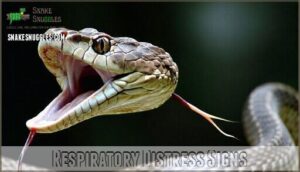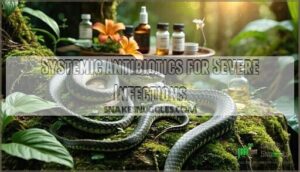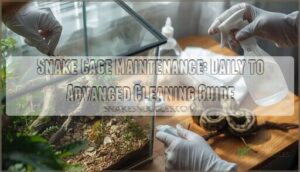This site is supported by our readers. We may earn a commission, at no cost to you, if you purchase through links.

Your first move is to get to an exotic vet immediately for proper antibiotics – both systemic and topical treatments are usually needed.
Meanwhile, clean that enclosure thoroughly and fix any husbandry issues like poor humidity or dirty substrate. Think of it as giving your snake a fresh start in a hospital-clean environment.
Surgical debridement might be necessary for severe cases, removing damaged tissue so healthy skin can heal. The recovery process involves more than just medication though.
Table Of Contents
- Key Takeaways
- How to Treat Snake Bacterial Infection?
- Identifying Snake Bacterial Infections
- Symptoms of Bacterial Infections in Snakes
- Causes of Snake Bacterial Infections
- Diagnostic Methods for Snake Bacterial Infections
- Antibiotics for Treating Snake Bacterial Infections
- Importance of Correct Husbandry for Recovery
- Surgical Debridement in Bacterial Infections
- Topical Antibiotics for Bacterial Dermatitis
- Systemic Antibiotics for Severe Infections
- Prognosis and Follow-Up Care
- Frequently Asked Questions (FAQs)
- What antibiotics are used for snake respiratory infections?
- How do you know if a snake is infected?
- Will a snakes respiratory infection go away on its own?
- What is a snake’s bacteria disease?
- Can bacterial infections in snakes spread to humans?
- Are there natural remedies for treating snake bacterial infections?
- Can snakes develop antibiotic resistance from repeated treatments?
- What preventive measures reduce the risk of bacterial infections?
- How often should antibiotics be given to snakes?
- Can bacterial infections spread between pet snakes?
- Conclusion
Key Takeaways
- Get to an exotic vet immediately – You’ll need both systemic and topical antibiotics prescribed by a reptile specialist, as bacterial infections can quickly become life-threatening without proper treatment.
- Clean your snake’s enclosure thoroughly – Fix husbandry issues like poor humidity, dirty substrate, or contaminated water to create a hospital-clean environment that supports healing.
- Watch for early warning signs – Look for behavioral changes like lethargy or appetite loss, plus physical symptoms like skin lesions, respiratory distress, or unusual swellings before they worsen.
- Follow treatment protocols exactly – Complete the full antibiotic course as prescribed and maintain proper environmental conditions throughout recovery to prevent antibiotic resistance and ensure successful healing.
How to Treat Snake Bacterial Infection?
When your snake develops a bacterial infection, quick action saves lives.
First, contact a reptile veterinarian immediately – they’re your best ally in this health battle.
The vet will perform diagnostic tests like blood work and bacterial cultures to identify the specific culprit causing trouble.
Antibiotic therapy forms the backbone of treatment, but here’s the catch: the right antibiotic matters.
Your vet will choose medications based on sensitivity results, ensuring maximum effectiveness against the specific bacteria involved.
Meanwhile, you’ll need to master infection control through proper snake hygiene.
Clean environments aren’t just nice-to-have; they’re essential for recovery.
Wound care becomes vital if injuries are present.
For serious cases like septicemia treatment, expect intensive antibiotic treatment for snakes combined with supportive care.
Remember, treating snake sepsis requires professional intervention – don’t go it alone when your reptile’s life hangs in the balance.
Identifying Snake Bacterial Infections
Spotting bacterial signs in your snake isn’t always obvious—these crafty reptiles hide illness well.
Watch for unusual swellings or abscesses that weren’t there yesterday.
Your snake’s normal routine matters; subtle changes in snake behavior signal trouble brewing.
Regular health checks help catch problems early, before they escalate into serious snake bacterial infection cases.
Diagnostic tools like visual inspection and behavioral monitoring are your first line of defense.
Don’t rely on guesswork—snake bacterial infection symptoms can be sneaky.
Professional snake bacterial infection diagnosis often reveals what you’ve missed.
Different infection types require different approaches, so accurate identification matters.
Remember, bacterial infection doesn’t announce itself with fanfare.
Your observational skills combined with veterinary expertise create the best detection system for protecting your scaly friend’s health.
Understanding common infection signs is essential for early detection and effective treatment.
Symptoms of Bacterial Infections in Snakes
You’ll need to recognize the warning signs early to get your snake the right treatment before things get serious.
Bacterial infections can show up in different ways, from obvious skin problems to subtle changes in how your snake acts around feeding time, which can be a key indicator of underlying bacterial infections.
Skin Lesions and Ulcers
Red, swollen patches on your snake’s belly often signal the first warning signs of bacterial skin infections.
These lesions start small but can quickly develop into painful ulcers if left untreated.
You’ll notice raised bumps, open wounds, or crusty areas that weren’t there before.
Proper wound care and dermatitis management become critical once these symptoms appear.
Respiratory Distress Signs
When your snake shows signs of respiratory distress, you’ll notice open mouth breathing and wheezing symptoms that sound like tiny whistles.
Gasping sounds and visible breathing difficulty often signal respiratory failure is approaching.
These snake respiratory infections can quickly escalate into serious respiratory disease.
Snake bacterial respiratory infections affecting the respiratory tract infections require immediate veterinary attention—don’t wait when breathing becomes labored.
Behavioral Changes Indicating Illness
In regards to snake health problems, behavioral changes often serve as your first warning system. Your snake’s daily habits can shift dramatically as bacterial infections take hold, making these snake behavioral changes vital indicators to monitor.
Lethargy Signs and Appetite Loss top the list of concerning behaviors. You’ll notice your normally active snake becoming sluggish, spending excessive time hiding, or refusing meals entirely. Aggression Issues may also emerge—a typically docile snake might suddenly become defensive or strike without provocation.
Watch for these key snake infection symptoms:
- Posture Changes like abnormal coiling or difficulty maintaining normal positioning
- Reduced movement or reluctance to explore their enclosure
- Swimming Patterns alterations in aquatic species, suggesting possible septicemia
- Unusual hiding behaviors or staying in one spot for extended periods
These snake disease symptoms often precede visible physical signs, making behavioral observation your best early detection tool for snake bacterial infection symptoms.
Causes of Snake Bacterial Infections
Understanding what causes bacterial infections in your snake is the first step toward prevention and effective treatment.
Most bacterial infections stem from three main culprits: environmental stress from poor humidity or temperature control, injuries that aren’t properly cleaned, and dirty living conditions that let harmful bacteria multiply.
Environmental Stress Factors
Your snake’s environment can make or break its health.
Your snake’s home is either healing sanctuary or bacterial breeding ground.
When humidity control goes haywire or temperature fluctuations become routine, you’re setting up your pet for trouble.
Poor water quality acts like a slow poison, while inadequate enclosure management creates bacterial playgrounds.
Environmental stress weakens immune systems faster than you’d think.
Add parasites like mites into the mix, and you’ve got a recipe for disaster.
Proper stress reduction through consistent temperature control and clean conditions keeps bacterial infections at bay, ensuring a healthy environment that supports your pet and prevents bacterial infections.
Traumatic Injury Complications
While environmental factors set the stage for infections, physical injuries open the door wide for bacteria to invade. Traumatic injury creates entry points where harmful microorganisms can establish themselves and multiply rapidly.
Wound Care becomes your first line of defense against Bacterial Abscess formation. Clean injuries immediately with antiseptic solutions and monitor for signs of infection. Snake wound treatment requires consistent attention—even minor cuts can become serious problems if neglected.
Your Trauma Response should include:
- Immediate cleaning with diluted betadine or chlorhexidine solution
- Daily wound management checks for swelling, discharge, or unusual odors
- Injury Prevention through safe handling techniques and secure enclosures
- Quick veterinary consultation for deep wounds or suspected Septic Shock
Poor Husbandry Conditions
While traumatic injuries open the door to infection, dirty enclosures create the perfect breeding ground for bacteria.
Poor husbandry turns your snake’s home into a bacterial playground. Contaminated bedding, inadequate cage cleaning, and poor water quality stress your pet’s immune system.
When humidity control fails and environmental stress builds up, even minor wounds become major problems. Think of it like living in a messy apartment – eventually, something’s going to make you sick.
Regular husbandry improvements prevent most snake bacterial infections, and maintaining good environmental stress control is crucial for your pet’s health.
Diagnostic Methods for Snake Bacterial Infections
Knowing the signs of snake bacterial infection is just the beginning—accurate diagnostic testing makes all the difference in your snake’s recovery.
Your veterinarian will start with a thorough physical examination, then recommend specific tests based on what they observe.
Think of it like detective work: each test provides another clue to solve the bacterial mystery.
Blood tests reveal infection markers and help assess your snake’s overall health status.
Bacterial cultures from lesions or respiratory secretions identify the exact pathogen causing trouble.
Imaging studies like X-rays or ultrasounds can spot hidden internal abscesses that aren’t visible during examination.
Here’s what diagnostic testing typically includes:
- Gram stains provide quick identification of bacterial types
- Culture sensitivity testing determines which antibiotics work best
- Swab analysis from the mouth or respiratory tract pinpoints respiratory infections
Sometimes biopsies become necessary for definitive snake bacterial infection diagnosis.
While these procedures might sound intimidating, they’re your best shot at getting the right treatment plan.
Identifying bacterial infection signs is vital for effective treatment and recovery.
Antibiotics for Treating Snake Bacterial Infections
Why settle for guesswork when treating snake bacterial infection? Your vet will select antibiotics based on bacterial strains identified through culture testing.
Fluoroquinolones and aminoglycosides are commonly prescribed for snake antibiotics, but antibiotic resistance makes sensitivity testing vital. Proper dosage calculation depends on your snake’s weight and species.
Treatment duration typically extends longer than mammals due to slower reptilian metabolism. Injection methods guarantee rapid systemic distribution for severe infections.
Never stop antibiotic treatment for snakes early—incomplete courses fuel resistant bacterial strains. Understanding bacterial cell walls is key to effective antibiotic treatment in snakes.
Importance of Correct Husbandry for Recovery
Beyond antibiotics, your snake’s recovery hinges on proper hygiene and clean enclosures.
You’ll need to maintain humidity control while implementing strict snake hygiene protocols. Think of it as creating a spa retreat for healing.
Environmental enrichment supports immune function, while nutrition management fuels recovery.
Good reptile husbandry prevents snake environmental stress that weakens defenses. Snake husbandry isn’t just maintenance—it’s medicine.
Your attention to snake bacterial infection treatment through environmental care makes all the difference.
Surgical Debridement in Bacterial Infections
When conservative treatment falls short, surgical debridement becomes your veterinarian’s go-to solution for severe snake bacterial infection treatment.
This precise procedure uses specialized surgical tools like scalpels and curettes for effective tissue removal of dead, infected material.
Professional debridement techniques eliminate harmful biofilm while promoting faster healing through improved wound cleaning.
Your vet will carefully assess tissue viability during the process, ensuring ideal infection control.
The procedure requires proper anesthesia and sterile conditions.
Wound debridement typically shows excellent results when performed by experienced reptile veterinarians, giving your snake the best shot at recovery.
Effective wound care methods are vital for preventing further complications and promoting healing in snake bacterial infections.
Topical Antibiotics for Bacterial Dermatitis
When dealing with bacterial dermatitis in snakes, topical antibiotics become your frontline defense against skin infections.
Antibiotic ointments deliver concentrated medication directly to bacterial lesions, ensuring faster healing than systemic treatments. Here’s what makes topical therapy effective:
- Dermatitis treatment works best with direct application to infected areas
- Prescription formulations outperform over-the-counter options substantially
- Snake skin infections respond well to neomycin-based preparations
- Regular application prevents bacterial lesions from spreading further
Apply these medications twice daily, following your vet’s dosing instructions carefully. Clean the affected area gently before each application. Monitor for skin irritation during antibiotic treatment – some snakes show sensitivity to certain formulations.
The use of topical antibiotic products is vital in preventing the spread of infection.
Systemic Antibiotics for Severe Infections
While topical treatments work well for surface issues, systemic antibiotics become your lifeline when septicemia threatens your snake’s survival.
You’re fighting bacterial strains that have invaded the bloodstream, requiring powerful antibiotic administration to achieve positive treatment outcomes.
| Antibiotic Type | Target Bacteria | Severe Symptoms Treated |
|---|---|---|
| Enrofloxacin | Gram-positive/negative | Respiratory distress, lethargy |
| Amikacin | Resistant gram-negative | Septicemia, organ failure |
| Meropenem | Multi-drug resistant | Systemic infection, shock |
| Clindamycin | Anaerobic bacteria | Abscesses, tissue necrosis |
| Linezolid | MRSA strains | Blood poisoning, convulsions |
Your vet will determine dosage based on species and weight.
Antibiotic resistance makes infection control challenging, so completing the full course remains non-negotiable for successful snake bacterial infection treatment.
Understanding systemic antibiotic properties is essential for effective infection management.
Prognosis and Follow-Up Care
Your snake’s recovery rates depend on catching the infection early and following your vet’s care plans.
Prognosis factors include infection severity, your pet’s age, and overall health.
Schedule regular follow up appointments to monitor healing and adjust treatment if needed.
Watch for signs of antibiotic resistance like recurring symptoms.
Maintain proper humidity and temperature during snake recovery – these environmental factors can make or break your followup care success.
Most snakes bounce back well with consistent post treatment monitoring and improved husbandry practices.
Regular check-ups with a veterinarian experienced in snake health care are essential for preventing and managing infections.
Frequently Asked Questions (FAQs)
What antibiotics are used for snake respiratory infections?
Injectable antibiotics like enrofloxacin or ceftazidime are your snake’s lifeline against respiratory infections.
You’ll need a reptile vet to diagnose the specific bacteria and prescribe the right antibiotic based on culture results, which is a lifeline against these infections.
How do you know if a snake is infected?
Look for behavioral changes like lethargy, loss of appetite, or unusual aggression. Watch for physical signs including swellings, skin lesions, respiratory distress, or abnormal posture that indicate infection.
Will a snakes respiratory infection go away on its own?
Respiratory infections won’t resolve on their own and can quickly become life-threatening without proper treatment. You’ll need antibiotics, supportive care, and environmental corrections to help your snake recover successfully.
What is a snake’s bacteria disease?
Bacterial infections in snakes are serious health conditions where harmful bacteria invade your pet’s body, causing symptoms like mouth rot, skin lesions, respiratory distress, and potentially life-threatening septicemia.
These symptoms require immediate veterinary treatment to prevent further complications and ensure the snake’s recovery.
Can bacterial infections in snakes spread to humans?
Unfortunately, yes — certain bacterial infections in snakes can jump to humans.
Common culprits include Salmonella, Mycobacterium, Campylobacter, and Aeromonas.
You’ll catch these through contact with contaminated surfaces, poor hygiene, or handling infected reptiles carelessly, which can lead to infections from these bacteria.
Are there natural remedies for treating snake bacterial infections?
Natural remedies aren’t effective for bacterial infections in snakes.
You’ll need veterinary-prescribed antibiotics since these infections can quickly become life-threatening.
Home treatments might actually delay proper care, making things worse for your snake.
Can snakes develop antibiotic resistance from repeated treatments?
Yes, snakes can develop antibiotic resistance from repeated treatments.
Overuse creates resistant bacterial strains, making future infections harder to treat.
That’s why vets perform culture tests to choose targeted antibiotics and avoid unnecessary treatments, which helps prevent the development of resistant bacterial strains.
What preventive measures reduce the risk of bacterial infections?
Think of prevention as building a fortress around your snake’s health.
You’ll need to maintain proper humidity, clean the enclosure regularly, guarantee adequate temperatures, provide fresh water, and promptly treat any wounds or injuries to ensure your snake’s overall well-being and health.
How often should antibiotics be given to snakes?
Antibiotic frequency depends on your veterinarian’s diagnosis and the specific medication prescribed.
You’ll typically give doses daily or every other day for 7-14 days, but never guess—always follow your vet’s exact instructions for dosage timing, and remember to never guess.
Can bacterial infections spread between pet snakes?
Bacterial infections can definitely spread between pet snakes, especially through shared equipment, contaminated water, or direct contact.
You’ll want to quarantine sick snakes immediately and disinfect everything thoroughly to protect your other reptiles.
Conclusion
Sure, treating bacterial infections might seem overwhelming at first, but you’ve got this with the right approach.
Learning how to treat snake bacterial infection successfully requires patience, proper veterinary care, and consistent husbandry improvements.
Remember that quick action, professional antibiotics, and a spotless environment are your best weapons against infection.
Your snake’s recovery depends on following treatment protocols exactly as prescribed and maintaining ideal conditions throughout the healing process.
- https://www.msdvetmanual.com/exotic-and-laboratory-animals/reptiles/bacterial-diseases-of-reptiles
- https://www.researchgate.net/profile/Iliana-Ruzhanova-Gospodinova/publication/384533472_Microbiological_Analysis_of_Laryngeal_and_Oral_Swab_Samples_from_Captive-Bred_Snakes_with_Respiratory_Tract_Infections_in_Bulgaria/links/66fc3e1a553d245f9e477c40/Microbiological-Analysis-of-Laryngeal-and-Oral-Swab-Samples-from-Captive-Bred-Snakes-with-Respiratory-Tract-Infections-in-Bulgaria.pdf
- https://pmc.ncbi.nlm.nih.gov/articles/PMC10891919/
- https://www.sciencedirect.com/science/article/abs/pii/S1572100017303915
- https://www.mdpi.com/2072-6651/16/1/37

















